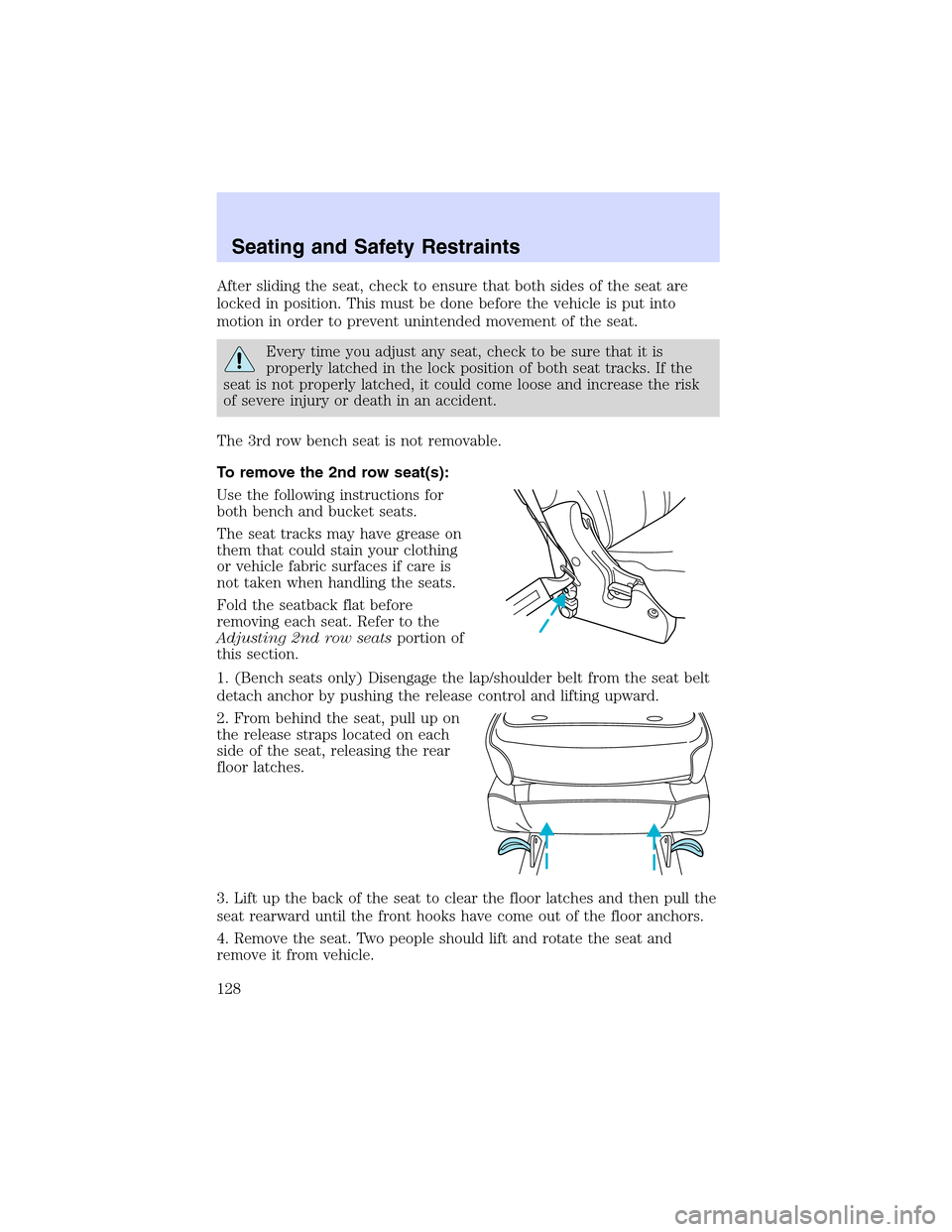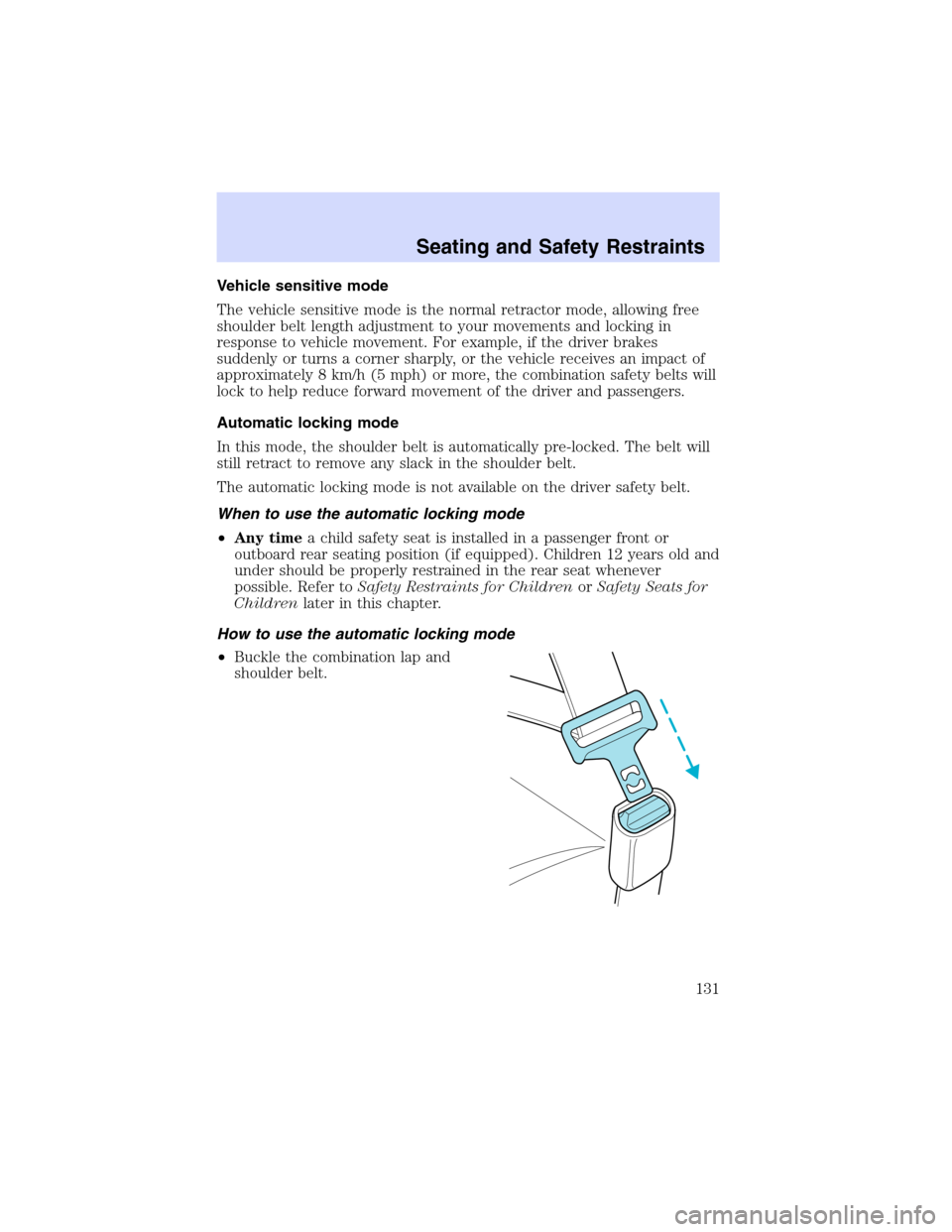remove seats Mercury Villager 2002 Owner's Manuals
[x] Cancel search | Manufacturer: MERCURY, Model Year: 2002, Model line: Villager, Model: Mercury Villager 2002Pages: 256, PDF Size: 1.91 MB
Page 60 of 256

•To reduce humidity buildup inside the vehicle in warm weather
conditions, don’t drive with the climate control system in the OFF
position.
•Under normal weather conditions, your vehicle’s climate control
system should be left in any position other than the MAX A/C or OFF
when the vehicle is parked. This allows the vehicle to“breathe”
through the outside air inlet duct.
•Under snowy or dirty weather conditions, your vehicle’s climate
control system should be left in the OFF position when the vehicle is
parked. This allows the climate control system to be free from
contamination of outside pollutants.
•If your vehicle has been parked with the windows closed during warm
weather conditions, the air conditioner will perform more efficiently in
cooling the vehicle if driven for two or three minutes with the
windows open. This will force most of the hot, stale air out of the
vehicle. Once the vehicle has been“aired out”, operate the climate
control system as desired.
•Do not put objects under the front seat which may interfere with the
airflow to the rear seats (if equipped).
•Remove any snow, ice or leaves from the air intake area (at the
bottom of the windshield and underneath the hood).
•Do not place objects over the defroster outlets. These objects can
block airflow and reduce visibility through your windshield. Avoid
placing small objects on top of the instrument panel. These objects
may fall down into the defroster outlets and block airflow, in addition
to, damaging the climate control system.
To aid in side window defogging/demisting in cold weather conditions:
1. Select the position that distributes air through the Panel and Floor.
2. Set the temperature control to full heat.
3. Set the fan speed to full fan.
4. Direct the outer panel vents towards the side windows.
5. To increase airflow to the outer panel vents, close the central panel
vents.
Do not place objects on top of the instrument panel as these
objects may become projectiles in a collision or sudden stop.
Climate Controls
60
Page 69 of 256

•Do not place objects under the front seat that will interfere with the
airflow to the rear seats.
•Remove any snow, ice or leaves from the air intake area at the base of
the windshield.
•Do not place objects over the defroster outlets. These objects may
block airflow and reduce visibility through your windshield. Avoid
placing small objects on top of your instrument panel. These objects
can fall down into the defroster outlets and block airflow, in addition
to, damaging the climate control system.
To aid in defogging/demisting in cold weather conditions:
1. Select
.
2. Set the temperature control to full heat
3. Set the fan speed to HI
4. Direct the outer panel vents towards the side windows
To increase airflow to the outer panel vents, close the central panel
vents.
Do not place objects on top of the instrument panel, as these
objects may become projectiles in a collision or sudden stop.
REAR PASSENGER AIR CONDITIONING SYSTEM—EATC
SYSTEMS
On vehicles equipped with front passenger EATC systems, the vehicle
will also have rear passenger compartment climate controls, which allow
the rear seat occupants to adjust their air conditioning level.
Climate Controls
69
Page 106 of 256

Front Cargo net (if equipped)
The front cargo net can be used to
hold small items between the front
seats. To install the net, secure the
hooks into the retainers located on
the inboard base of the front seats.
Parcel Shelf (if equipped)
Your vehicle may be equipped with a
14 kg (30 lbs.) maximum capacity
parcel shelf located behind the rear
seat of your vehicle which can be
positioned to three different heights.
To remove the shelf:
1. Open the liftgate.
2. Disconnect the net loop from the
retainer underneath the shelf to
access the lock knob.
3. Turn the lock knob
counterclockwise and slide the knob
to the UNLATCH position.
4. Remove the shelf from the
vehicle.
To install the shelf:
1.
Position and slide the shelf into the
right mounting bracket; then align the
shelf into the left mounting bracket.
2. Slide the lock knob to the LATCH position and tighten the lock knob
clockwise.
3. Connect the net loop to the retainer underneath the shelf and close
the liftgate.
To secure objects on the shelf:
1. Disconnect the net loops from the retainers underneath the shelf.
2. Place the objects underneath the net and secure the net loops to the
retainers underneath the shelf.
LOCK
Driver Controls
106
Page 119 of 256

2. Press button 1 or 2 and hold for at least two seconds. The indicator
light will stay on until the position is programmed. When the position has
been programmed, the indicator light will flash three times. Repeat
procedure for second position.
To record a remote entry transmitter:
1. Program a desired position to a memory switch as indicated above.
2. Press and hold the desired memory position button. Within ten
seconds, press the unlock button on the transmitter while the memory
button is pressed.
3. When the transmitter has been programmed, the indicator will flash
five times. The indicator light will remain illuminated until the memory
button is pressed again or ten seconds lapse.
To remove a programmed seat position:
1. Press and hold both memory seat buttons 1 and 2 and then press the
unlock button on the remote entry transmitter.
REAR SEATS
Removable floor mats
Whenever the floor mats are removed to adjust or move any of the rear
seats, always reinstall the mats before passengers ride in the vehicle. The
floor mats are specifically designed to keep objects out of the seat
tracks.
•7 passenger vehicle
A. Cargo mat (if equipped)
B. Narrow mats
C. Sliding door mats, LH/RH
ACB
Seating and Safety Restraints
119
Page 120 of 256

•4 passenger vehicle (with third row seat in storage position)
A. Cargo mat (if equipped)
B. Narrow mats
C. Sliding door mats, LH/RH
•5 passenger vehicle (second row seats removed)
A. Cargo mat (if equipped)
B. Narrow mats
C. Sliding door mats, LH/RH
•5 passenger vehicle (second row seats removed and third row bench
seat moved forward to limousine seating position)
A. Cargo mat (if equipped)
ABCB
BAB
C
Seating and Safety Restraints
120
Page 121 of 256

B. Narrow mats
•Two passenger vehicle (second row seats removed and third row seat
stored in full forward position—if equipped with Rear Seat
Entertainment System, the third row seat cannot be put into this
position.)
A. Cargo mat (if equipped)
B. Narrow mats
AB
AB
Seating and Safety Restraints
121
Page 126 of 256

The entire seat can be moved to four seating positions and two storage
positions.
Before rearranging the seats, remove any floor mats that might be in the
way, seeRemovable floor matsin this chapter for instructions on
placement of floor mats.
For vehicles equipped with a second row bench seat: If the three
passenger bench seat is moved up to the second row position, the
outside passenger (opposite the driver) should fasten the
standard lap/shoulder belt. The secondary seat belt tongue is not
fastened to the outside bottom of the seat (as does the two
passenger bench seat). This is not required with the three
passenger bench seat since the seat is much wider.
The seat tracks may have grease on them that could stain your clothing
or vehicle fabric surfaces if care is not taken when handling the seats.
A. Three rearward seating positions
B. Limousine seating position (3rd row seat with 2nd row seat removed)
C. Two storage positions (If equipped with a Rear Seat Entertainment
System, the second row seat cannot be locked in the forward most
position.)
AC
B
Seating and Safety Restraints
126
Page 128 of 256

After sliding the seat, check to ensure that both sides of the seat are
locked in position. This must be done before the vehicle is put into
motion in order to prevent unintended movement of the seat.
Every time you adjust any seat, check to be sure that it is
properly latched in the lock position of both seat tracks. If the
seat is not properly latched, it could come loose and increase the risk
of severe injury or death in an accident.
The 3rd row bench seat is not removable.
To remove the 2nd row seat(s):
Use the following instructions for
both bench and bucket seats.
The seat tracks may have grease on
them that could stain your clothing
or vehicle fabric surfaces if care is
not taken when handling the seats.
Fold the seatback flat before
removing each seat. Refer to the
Adjusting 2nd row seatsportion of
this section.
1. (Bench seats only) Disengage the lap/shoulder belt from the seat belt
detach anchor by pushing the release control and lifting upward.
2. From behind the seat, pull up on
the release straps located on each
side of the seat, releasing the rear
floor latches.
3. Lift up the back of the seat to clear the floor latches and then pull the
seat rearward until the front hooks have come out of the floor anchors.
4. Remove the seat. Two people should lift and rotate the seat and
remove it from vehicle.
Seating and Safety Restraints
128
Page 131 of 256

Vehicle sensitive mode
The vehicle sensitive mode is the normal retractor mode, allowing free
shoulder belt length adjustment to your movements and locking in
response to vehicle movement. For example, if the driver brakes
suddenly or turns a corner sharply, or the vehicle receives an impact of
approximately 8 km/h (5 mph) or more, the combination safety belts will
lock to help reduce forward movement of the driver and passengers.
Automatic locking mode
In this mode, the shoulder belt is automatically pre-locked. The belt will
still retract to remove any slack in the shoulder belt.
The automatic locking mode is not available on the driver safety belt.
When to use the automatic locking mode
•Any timea child safety seat is installed in a passenger front or
outboard rear seating position (if equipped). Children 12 years old and
under should be properly restrained in the rear seat whenever
possible. Refer toSafety Restraints for ChildrenorSafety Seats for
Childrenlater in this chapter.
How to use the automatic locking mode
•Buckle the combination lap and
shoulder belt.
Seating and Safety Restraints
131
Page 143 of 256

Types of booster seats
There are two types of belt-positioning booster seats:
•Those that are backless.
If your backless booster seat has a
removable shield, remove the
shield and use the lap/shoulder
belt. If a seating position has a
low seat back and no head
restraint, a backless booster seat
may place your child’s head (top
of ear level) above the top of the
seat. In this case, move the
backless booster to another
seating position with a higher seat back and lap/shoulder belts.
•Those with a high back.
If, with a backless booster seat,
you cannot find a seating position
that adequately supports your
child’s head, a high back booster
seat would be a better choice.
Both can be used in any vehicle in a seating position equipped with
lap/shoulder belts if your child is over 40 lbs.
The shoulder belt should cross the chest, resting snugly on the center of
the shoulder. The lap belt should rest low and snug across the hips,
never up high across the stomach.
If the booster seat slides on the vehicle seat, placing a rubberized mesh
sold as shelf or carpet liner under the booster seat may improve this
condition.
Seating and Safety Restraints
143